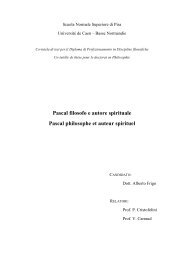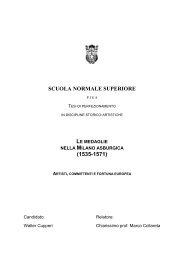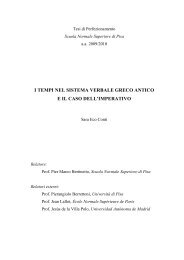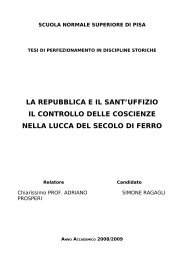CATULLUS 68 - Scuola Normale Superiore
CATULLUS 68 - Scuola Normale Superiore
CATULLUS 68 - Scuola Normale Superiore
You also want an ePaper? Increase the reach of your titles
YUMPU automatically turns print PDFs into web optimized ePapers that Google loves.
statistical likelihood and not to the rules of the language. In this case it is hard to see how this deictic<br />
pronoun could have been inserted by an interpolator, and it makes very good sense: it calls to life the scene<br />
of the poet in the process of replying to a letter, implying as it does ‘which I have in front of me’ (thus<br />
Thomson).<br />
It is not uncommon for Catullus to enact such a scene: in his letter in verse to Caecilius he addresses the<br />
letter-paper (35.2), while at the very start of the Liber he pretends to be poring over the completed book-roll<br />
and hesitating whom to dedicate it to (1.1f.). The latter parallel is almost certainly a fictitious scene (Catullus<br />
will have composed the dedication before the book-roll was completed), so this hoc hardly suffices to show<br />
that he was actually holding his correspondent’s letter in his hands, as he wrote this, pace Ellis, Kroll and<br />
Thomson. In fact, its function is not to point to the letter that he is holding in his hands (such a gesture would<br />
have no practical purpose whatsoever), but to let the reader imagine him as he does so. Of course, he may<br />
have been doing so as well; but as humanity is not genetically predisposed to telling the truth, a single word<br />
hardly suffices to show that.<br />
3f. Catullus recapitulates Manlius’ request for help through a metaphor in which Manlius is characterized as<br />
a shipwrecked man cast ashore by the sea, barely alive and in urgent need of a good Samaritan to lift him up<br />
and bring him back to life. After the phrase fortuna casuque oppressus acerbo (line 1n.) Manlius is<br />
characterized once again as having been afflicted by an elementary catastrophe, a disaster from outside.<br />
Commentators quote two kinds of parallels: occurrences of the Hellenistic motif of the Storm of Love, and of<br />
the homegrown Roman image of shipwreck standing for any kind of disaster. It is worthwhile to look at each<br />
of these in detail in order to understand better the origins of the image used by Catullus.<br />
The Storm of Love may have been inspired by Semonides of Amorgos’ comparison of women to the sea,<br />
treacherous and changeable (frg. 7.37-40 West), but it emerges fully in Greek epigram from the Hellenistic<br />
period onwards, where it is used by Hedylus or Asclepiades at A.P. 5.161, by Meleager at A.P. 12.157, by<br />
Philodemos at A.P. 10.21 = epigr. 8 Sider (cfr. Sider ad loc.), by the consul Macedonius at A.P. 5.235.5f.,<br />
and by the author of the anonymous epigram A.P. 12.156. In Latin poetry it is adopted by Horace at Od. 1.5<br />
(cfr. Nisbet & Hubbard 1970 ad loc.) and Propertius at 3.24.11-18. I quote in full one characteristic example,<br />
an epigram by Catullus’ contemporary Philodemus (A.P. 10.21 = epigr. 8 Sider):<br />
Κ⎛πρι γαληνα⇔η, φιλον⎛μφιε, Κ⎛πρι δικα⇔οιω<br />
σ⎛μμαξε, Κ⎛πρι Π〉ψϖν μ°τερ ελλοπ〉δϖν,<br />
Κ⎛πρι, τ∫ν ″μ⇔σπαστον π∫ κροκϒϖν ⁄μ′ παστ∩ν,<br />
τ∫ν ξι〉σι χυξ↓ν Κελτ⇔σι νειφ〉μενον,<br />
Κ⎛πρι, τ∫ν ″σ⎛ξι〉ν με, τ∫ν ο⎡δεν⇐ κϖ⎯φ λαλε⎝ντα,<br />
τ∫ν σϒο πορφυρϒ⊗ κλυζ〉μενον πελ γει,<br />
Κ⎛πρι φιλορμ⇔στειρα, φιλ〉ργιε, σ®ζϒ με, Κ⎛πρι,<br />
98






